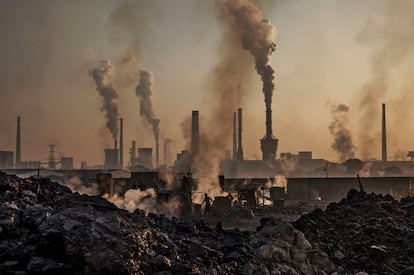China, a renewable giant addicted to coal
The Asian country is the world’s largest investor in clean energy, but it also had 95% of the planet’s coal-fired capacity by 2023

China has arrived at the climate summit being held in Dubai (COP28) as the world’s undisputed leader in clean energy. In 2022, the country invested almost half of global spending on low-emission technologies, or about $546 billion. That is three times more than the European Union ($180 billion) and the United States ($141 billion), according to BloombergNEF estimates. And this year it will set a record of new wind and photovoltaic capacity: 230 gigawatts (GW), in addition to 39 GW of thermal and 8 GW of hydraulic energy production, according to projections by the British consulting firm Wood Mackenzie. However, behind these achievements lies a trace of uncertainty: the country’s dependence on coal is deep-rooted, and China is still the largest emitter of carbon dioxide (CO₂) on the planet in absolute terms, not per capita.
The Asian giant has built more than 95% of the world’s coal-fired electricity generation capacity this year, according to the American think tank Global Energy Monitor (GEM). Concerned about the instability of renewable energy when there is no sun or wind, Beijing has accelerated the development of coal projects at an unprecedented rate, hiding behind the need to guarantee energy security.
Last year, China burned more coal than the rest of the planet, and more than 60% of its electricity was generated from the fuel, according to a report by the International Energy Agency (IEA) published in October. While the country has decommissioned 70.45 GW of coal plants in the last decade, and domestic production is estimated to peak around 2025, the speed they will be relegated to a secondary role remains uncertain, the agency warned.
In fact, since the Chinese government granted the lowest number of permits to the creation of coal-based energy plants in 2019, their construction has skyrocketed, according to data published by GEM researchers in November. “Not only is the commitment issued in 2021 by President Xi Jinping to ‘strictly control’ coal-fired power generation programs (…) being ignored, but the authorities have gone from discouraging to encouraging them,” said the NGO based in San Francisco.
While coal energy capacity outside the Asian superpower has plummeted since 2015, last year Chinese regulators set the goal of starting to build plants capable of producing 80 GW of new power in 2023, adding another 80 GW in 2024. Data from the GEM’s Global Coal Plant Tracker shows that, as of October 2023, China had a cumulative total of 136.2 GW under construction. In comparison, second place India had 31.6 GW. To put the figures in perspective, no Latin American country has begun construction on a coal-fired plant since 2016, and, since 2019, neither has any country in Europe, Africa, the Middle East or any members of the Organization for Cooperation and Economic Development (OECD).
For this reason, the new surge of unbridled construction has raised doubts about Beijing’s commitment to phase out the fossil fuel, which is the most polluting, and contributes to around 70% of the emissions from the world’s second-largest economy. In addition to CO₂ emissions, methane emissions are of concern. China is also the largest emitter of this greenhouse gas, at 28 million metric tons annually, according to the IEA, and on Sunday, Climate Trace revealed that coal mines were responsible for a large proportion of the increase in these emissions in 2021 and 2022. Last month, Xi Jinping and his American counterpart Joe Biden pledged to collaborate on finding ways to methane emissions and to include them in their next national climate plans. Beijing has already announced a roadmap, although without providing many details.
Reducing the use of coal used around the world is among the central points of the conversations that are taking place at the COP28. It was at the Glasgow climate summit, two years ago, when the Chinese president announced that his country would reach the peak of CO₂ emissions by the end of this decade and carbon neutrality (emitting the same amount of gases into the atmosphere that are absorbed by other means) before 2060. By 2030, China also hopes to reduce its CO₂ emissions per unit of GDP by at least 60% compared to 2005 levels and to generate 25% of its electricity through non-fossil fuels.
Dimitri de Boer, head of the Asia division of the Client Earth organization, believes that, “despite the investments in coal energy that are taking place,” the environment is still a priority. Proof of this comes in the form of the clean energy megaprojects that have been launched in the north of the country and the great commitment to new energy vehicles (China is the largest producer, consumer, and exporter of electric cars on the planet). “We predicted that China would enter a carbon peak plateau around this time, and some of the latest analysis suggests that may be happening,” says de Boer. The new challenge is that “the effects of climate change are beginning to hit the country, just when green technologies and electric mobility are taking off,” he points out.
Energy security
Despite being the nation with the greatest green energy production capacity, currently, solar and wind only generate 10% of total electricity. For this reason, the authorities use the argument that energy from coal guarantees a stable supply and supports the production of intermittent electricity from renewables.
“China had taken a more aggressive stance in favor of decarbonization before 2021, and it seemed that coal plants would disappear much faster than expected,” Cosimo Reis, an analyst at the consulting firm Trivium China, says by telephone. The energy crisis of autumn 2021 changed the course of events. Then, more than half of China’s provinces were forced to adopt some type of electricity rationing measure due to an unprecedented wave of blackouts. The following summer, heat waves and droughts also caused industrial blackouts in some regions. “There was a heated debate about the causes. Many voices stated that renewable energies were not reliable and that the system was not yet mature enough for the transition,” explains Reis, and “energy security could not be sacrificed,” he says.
Against this backdrop, the Development and Research Center, attached to the Chinese government, announced in September that electricity production capacity from coal could increase by more than 200 GW by the end of the decade. China’s top climate official, Xie Zhenhua, went so far as to describe the total elimination of fossil fuels as “unrealistic.” However, Reis believes that “it is not entirely clear” how many of these projects will finally see the light of day.
China also faces excess capacity for coal-fired electricity generation, with a plant utilization rate barely exceeding 50% in 2022. “For years, space on the grid was freed up for clean electricity. In fact, many of these coal plants are losing enormous amounts of money,” says Reis. Given this situation, starting January 1, the plants will receive fixed payments for capacity instead of for the electricity they generate. The regulators maintain that this will encourage the green transition and guarantee the financial viability of coal reserves, which are used at times of peak demand or when electricity from renewables is insufficient. “The share of coal in electricity production is falling, and that is not going to change,” says Reis, who adds that “it is undeniable that [this gamble] will help stabilize the system.”
“Our strategy consists of first building and then dismantling,” Sun Zhen, advisor to the Climate Change Department of the Ministry of Ecology and Environment, explained in October during a seminar organized by the United Nations and the Spanish Embassy in Beijing. “In this way we guarantee energy security while deploying new sources of renewable energy as quickly as possible, thus establishing a solid foundation to progressively reduce the use of fossil energy,” he said.
Greenpeace for East Asia, however, emphasizes that the key is to improve the technological infrastructure of the network and make it more stable and efficient, and they insist that “energy storage is crucial for the green transition.” The persistent challenge is to transport the energy that China produces (mainly in the western part of the country) to the places where it is consumed most (in the east of the nation). In fact, the five provinces that have approved the most coal plants since 2021 are the industrial centers and main importers of electricity.
Reis is optimistic about China’s green future: “This year we have seen record growth in solar and wind power capacity, and many in the industry believe they will be able to meet growing domestic demand, although of course it will take time.” “China has every intention of maintaining its leadership position and achieving its environmental objectives,” he adds.
Sign up for our weekly newsletter to get more English-language news coverage from EL PAÍS USA Edition
Tu suscripción se está usando en otro dispositivo
¿Quieres añadir otro usuario a tu suscripción?
Si continúas leyendo en este dispositivo, no se podrá leer en el otro.
FlechaTu suscripción se está usando en otro dispositivo y solo puedes acceder a EL PAÍS desde un dispositivo a la vez.
Si quieres compartir tu cuenta, cambia tu suscripción a la modalidad Premium, así podrás añadir otro usuario. Cada uno accederá con su propia cuenta de email, lo que os permitirá personalizar vuestra experiencia en EL PAÍS.
¿Tienes una suscripción de empresa? Accede aquí para contratar más cuentas.
En el caso de no saber quién está usando tu cuenta, te recomendamos cambiar tu contraseña aquí.
Si decides continuar compartiendo tu cuenta, este mensaje se mostrará en tu dispositivo y en el de la otra persona que está usando tu cuenta de forma indefinida, afectando a tu experiencia de lectura. Puedes consultar aquí los términos y condiciones de la suscripción digital.











































